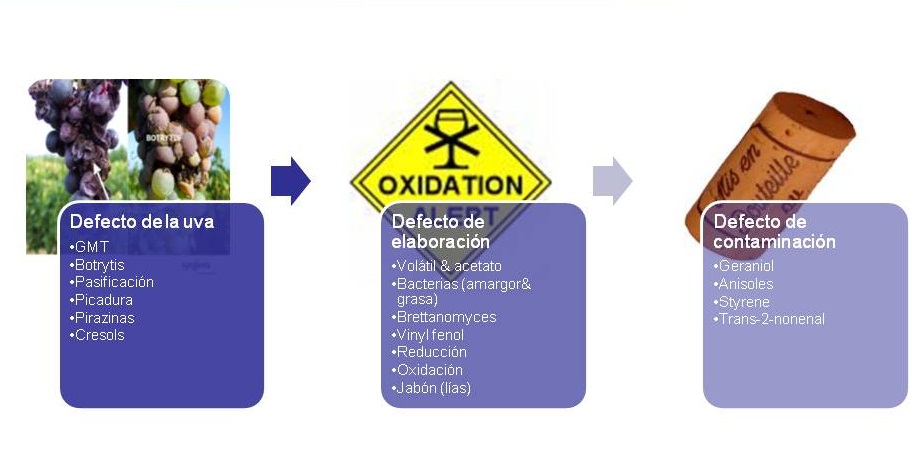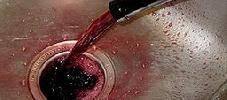Wine Mängel.
Als regelmäßiger Konsument von Wein, kann ich sagen, es ist ziemlich schwierig, alle fehlerhaften Wein zu finden. Die Technologie-und Qualitätskontrolle, die den Halt führt verhindert fast jede Möglichkeit, und die meisten der möglichen Defekte, die zutreffen können leicht durch Anblick oder Geruch erkannt.
 Ce ne sera pas la première ni la dernière personne qui, ayant débouché une bouteille de vin que vous avez jamais pensé que c'était défectueux. Toutefois, il est très possible que vous ne l'avez pas fait à ce sujet, et vous avez bu du vin sans qu'il vous le souhaitez. Peu de gens retournent le vin dans un restaurant ou dans un magasin. La raison? un mélange de timidité et d'incertitude. Nous nous disons: «Peut-être que le vin est bien, comme je ne suis pas un expert ...
Ce ne sera pas la première ni la dernière personne qui, ayant débouché une bouteille de vin que vous avez jamais pensé que c'était défectueux. Toutefois, il est très possible que vous ne l'avez pas fait à ce sujet, et vous avez bu du vin sans qu'il vous le souhaitez. Peu de gens retournent le vin dans un restaurant ou dans un magasin. La raison? un mélange de timidité et d'incertitude. Nous nous disons: «Peut-être que le vin est bien, comme je ne suis pas un expert ...
It will not be the first nor the last person who, having uncorked a bottle of wine you've ever thought that was defective. However it is very possible that you have not done anything about it, and you've drunk the wine without it you like. Few people return the wine in a restaurant or in a store. The reason? a mixture of shyness and uncertainty. We say to ourselves, "Maybe the wine is well, as I'm no expert ...
It's a complicated question to know if a wine has defect. For a person who is not an expert, but that is habitual drinker of wine, if your intuition tells you that there is something wrong, the chances are that wine is defective. I hope that after reading this article from The Essence of Wine, if this happens, and you detect a defect in a wine, not after paying a lot for one of the best wines I have thought to try.
Keep in mind that wine is a living element in constant evolution that requires a lot of care in its preparation for the end result desired product. But to open a bottle we can find a myriad of things that have gone wrong and therefore we are looking at a bottle "defective" and causes can be many. Wine Defects are relative since while for according to types of wine is made are beneficial (eg the re-fermentation in the bottle of Champagne or aerobic yeast growth in oak casks containing sherry, ...) to other wine are totally harmful, making the wine undrinkable liquid or of poor quality.
What are the normal or typical defects that we can find in a wine?
- Smell of cork. - Is it easier to detect defects. When a wine cork smell or odor that reminds having wet cardboard. This defect is not because it has fallen cork wine!. To understand this defect we must look to the origins of the cork: the Cork Oak tree and if the same has been infected with mold. Even if there are problems with mold in the winery with barrels, structures or corks. Causing the "cork odor" is Trichloroanisol or TCA and is a chemical reaction of organic compounds called phenols which are normally found in grapes, cork, barrels, etc. are combined with chlorine. Often in the process of whitening cork, this is washed with chlorine, if probiene Cork cork which had mold problems, this wash that makes it worse some corks. However there are other microorganisms capable of producing without the presence of chlorine TCA. If you serve a wine cork with this fault and believe that the wine is bad, in my opinion you should wait a little, and then, move the cup of wine and wine's defect will become more apparent, and will be more so after a few minutes. There have been many efforts in the wineries to end this wine defect, but even today there are connoisseurs who cite the statistics of one out of every fifteen bottles have this problem.
- Smell of rotten apples. - This is a defect that occurs when the wine is oxidized. To learn how to identify it, nothing better than having a bottle of that wine is slightly open a few days. Taste the wine then and learn to identify this defect caused by oxidation's wine.
- Smell of rotten eggs or rubber. - A reduced wine is one that has the smell of rotten eggs, garlic, or a group of plants that are decaying, nauseating really. It is produced by the hydrogen sulphide that appears in the wine during racking (wine vessel changes such as from Cuba to deposit), especially in warm regions by not having enough oxygen. If not treated effectively appear mercaptans giving the wine an unpleasant odor. It can be removed with aeration.
- Smell stable, old wood, horse sweat. - This defect wine is produced by the bacterium Brettanomyces ("bret") which may be due to a problem of hygiene in the winery, however these bacteria are always present in wine. However, the effect of this bacterium is sought by some producers to achieve the characteristic aromas.
- Musty odor and the color is brownish. - This defect is caused by oxidation and in some wines is deliberate (Sherries, madeiras, ...), but is something that is avoided in traditional wines where oxidation is considered a defect denoting a musty odor, acetaldehyde or ethanal, flavors muted with brownish tones.
- Taste sour (The wine is choppy.) - A sour wine is one that has a vinegar smell, taste weak and naturally sour. This defect is produced by the bacterium Acetobacter Aerobea or Acetylcysteine Micoderma. It develops on the surface of the wine in contact with the air, creating a white layer on this that a few days will turn pink. This bacterium subtracted wine alcohols and gives it volatile acidity.
- Taste sulfur. - A sulfur wine is one that has an odor that resembles that of a match when turned on, in terms of taste, provides dryness and itching. Result of the addition of excess sulfur dioxide at the stage of fermentation. With aeration of the glass or bottle can disappear.
- Taste or smell of wet earth. - Produced by a seaweed (Chatodotrix dichotoma), occurs when the grapes used for wine making were in contact or very close to the ground.
- Metallic taste or smell. - This defect is due to the wine has been in contact with a metallic element.
- The wine has many "stumble" - Known as bankruptcy cuprous or "bottle sickness", can be solved in storage but once bottled wine, no solution. The wine becomes cloudy and produce precipitation of copper salts. To avoid this we must be careful with the use of copper utensils in winemaking.
- On more than one occasion we had to return had refermentado wine in the bottle. This can happen if the producer has stopped fermentation early and has not stabilized or protected adequately wine. The result is a wine that seems to be moving in his mouth, and with a very strange taste.
- Wine maderizado. - Generally white wines with this defect have a darker color than normal, with the nose very flat, which does not have any attributes and whose taste is tart. If it is a red wine, we find little look brilliant, somewhat brownish color and as in white wines, very faint odor and flat. As for the taste, it seems to be a sweet and sour mix.
- Sometimes there are wines that are exhibiting certain grounds. This should not be confused with a defect, it is likely to be even a wine under the producer did not want to "clean up" excess wine to prevent this way they could lose many of their qualities. These grounds or mothers, are removed by decanting and the wine is in good condition.
In summary, what to do if you think your wine has a defect? My advice is always to stop and spend a few minutes once you confirm your first impression, do not be shy and tell the waiter or sommelier, in a natural way, without trying to pose as understood.







